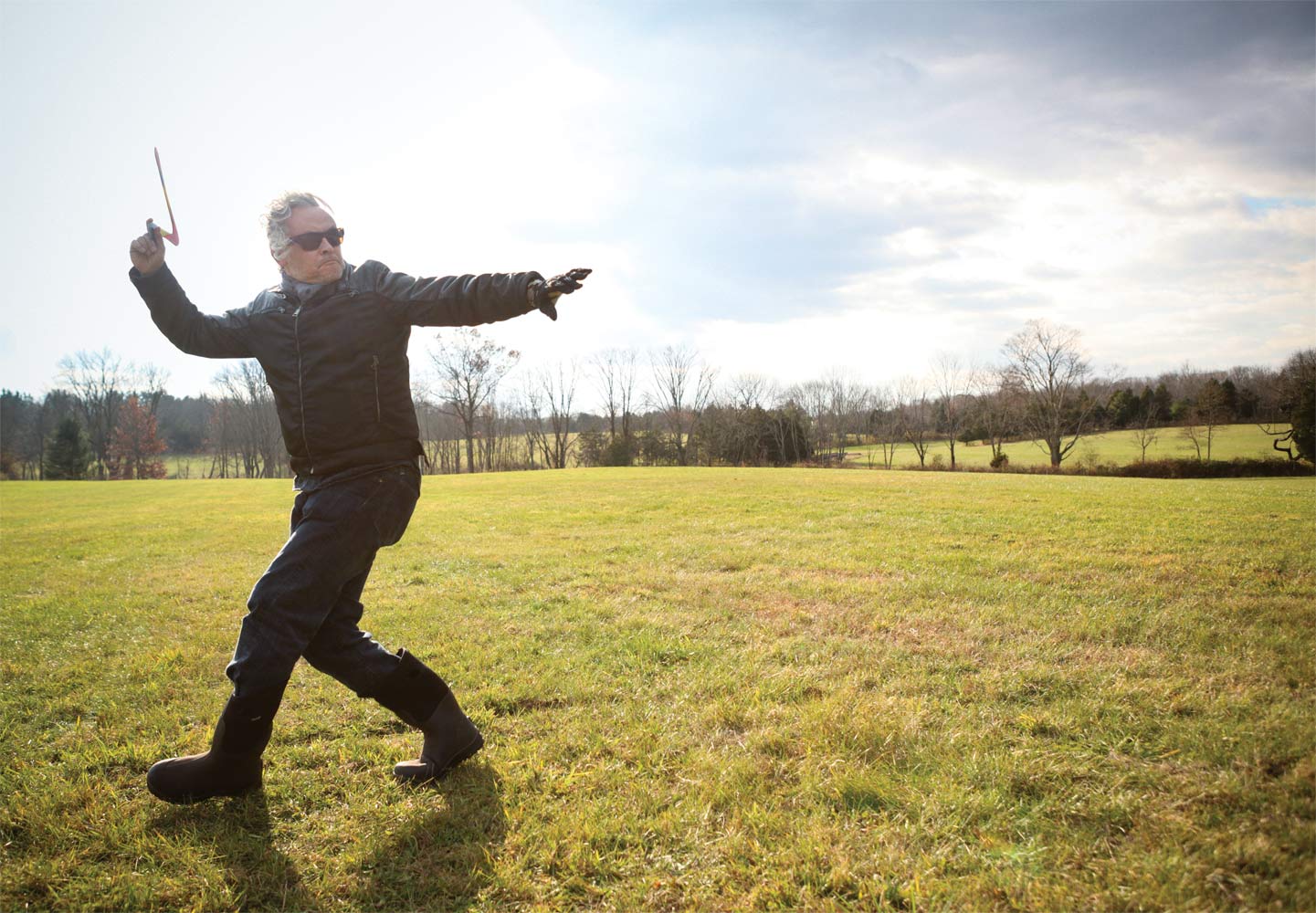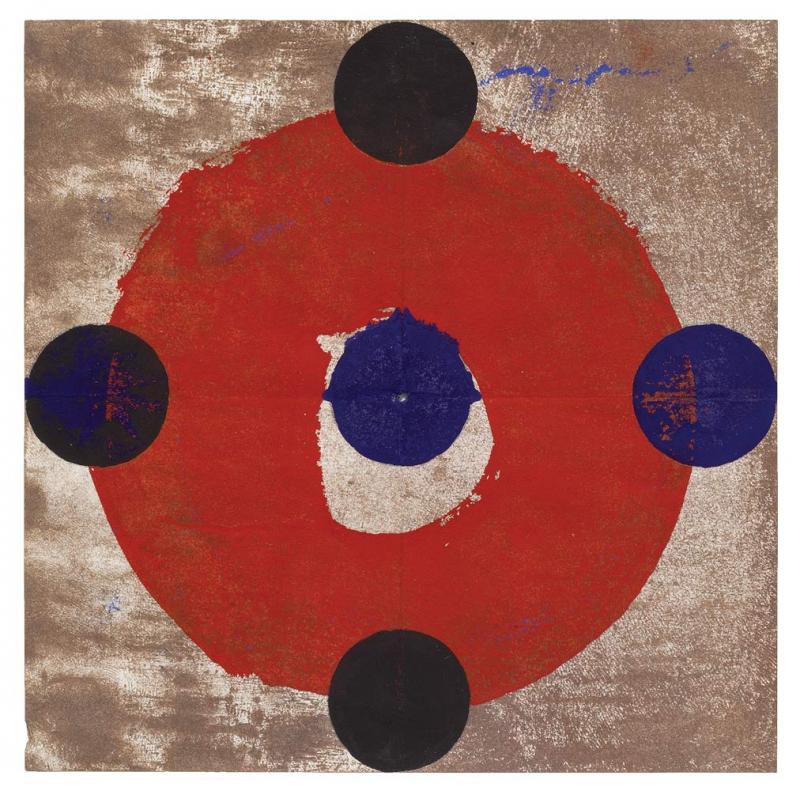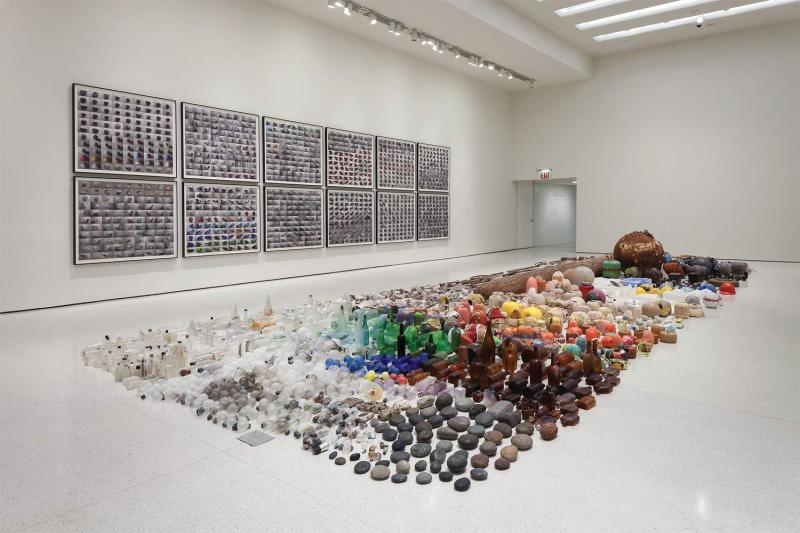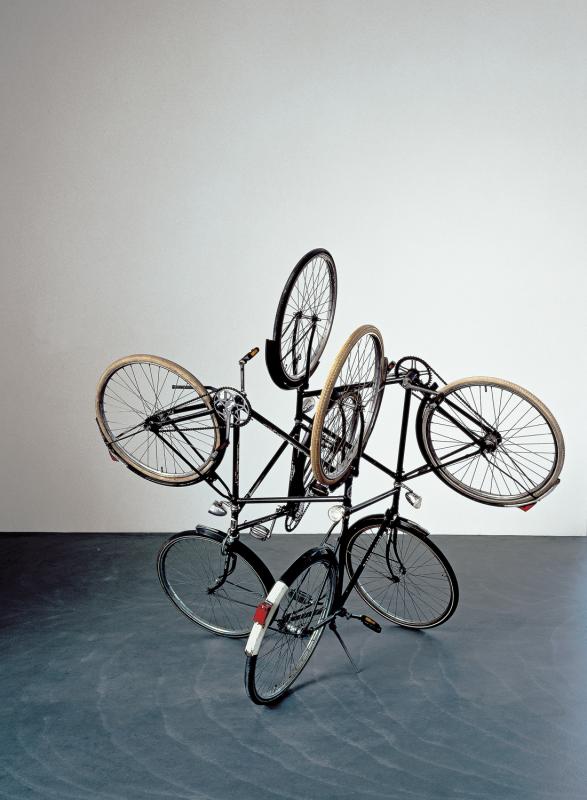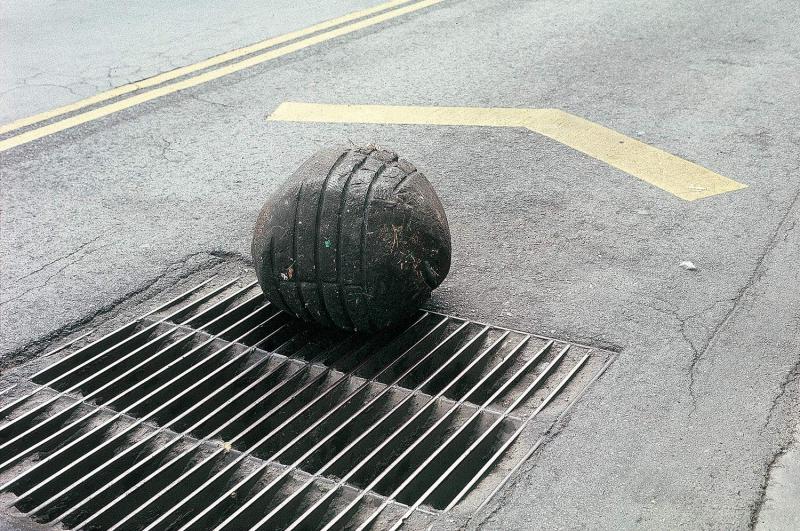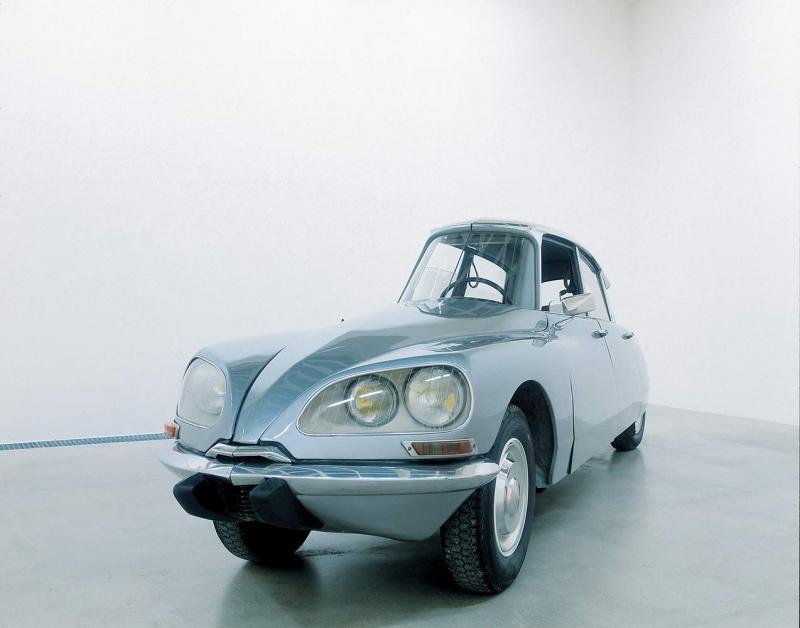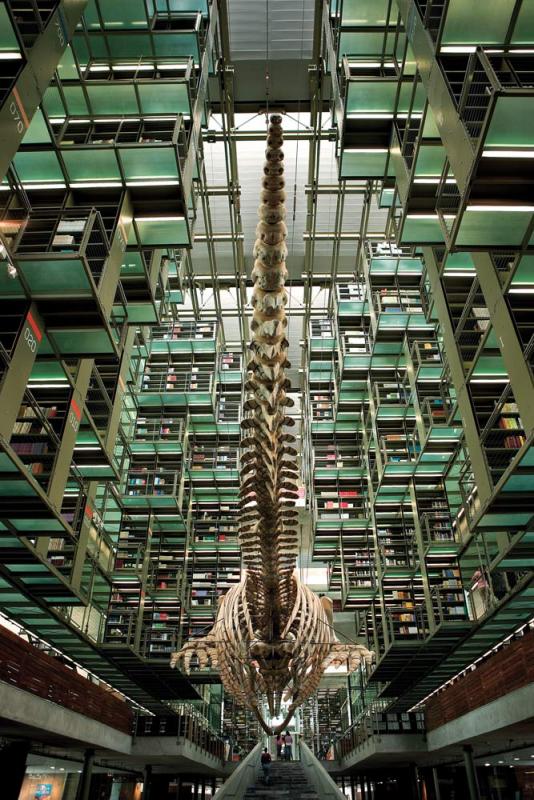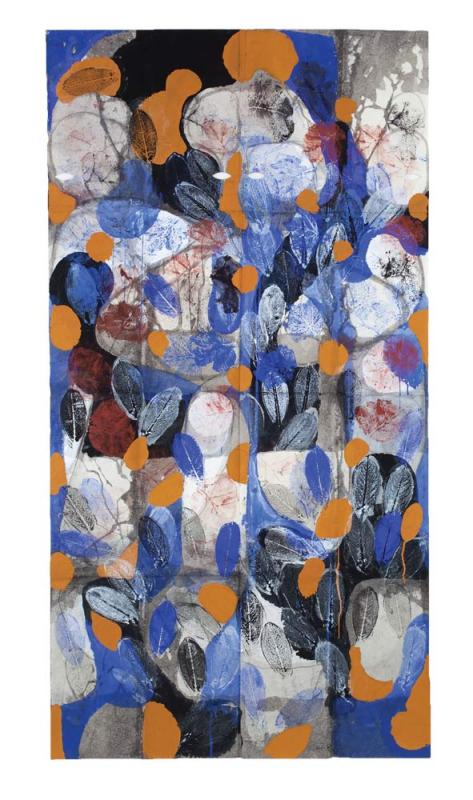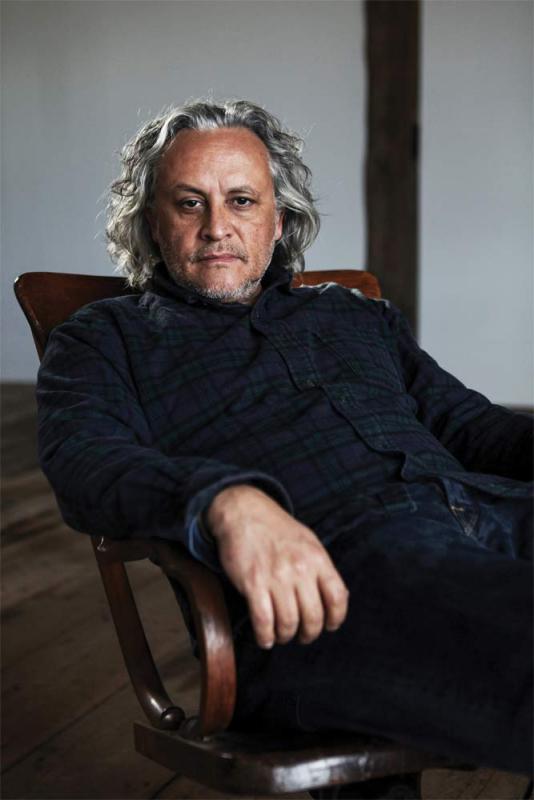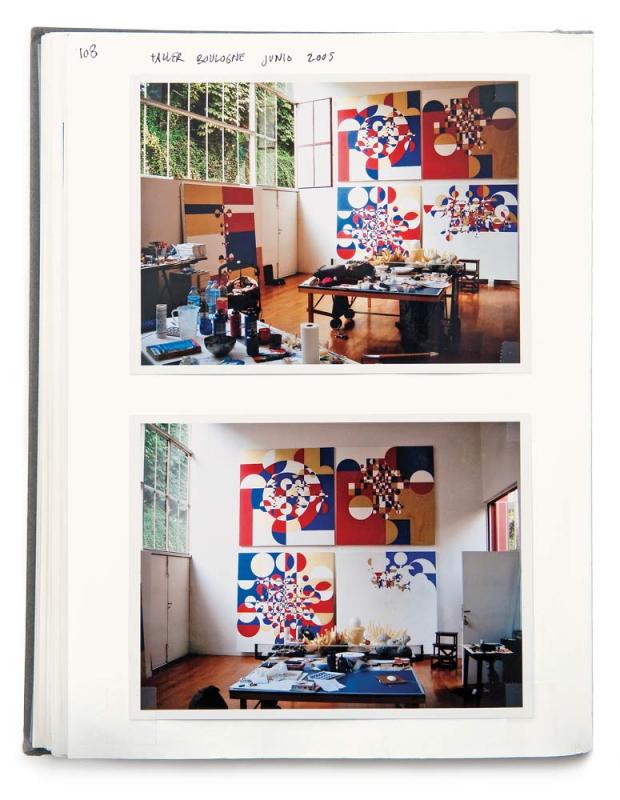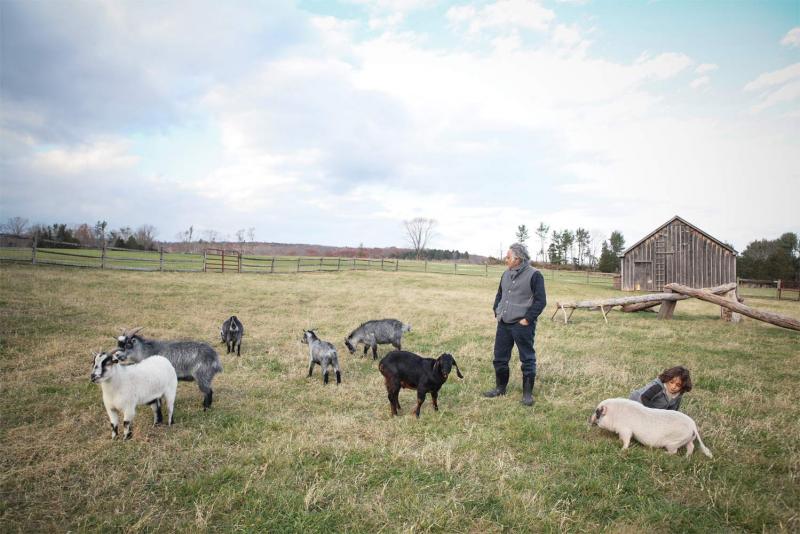Gabriel Orozco is a mercurial artist, enough so that, not three minutes after I arrived at his West Village home with plans to head out into the city, he suggested that perhaps I might like to help him draw circles instead. Specifically, he wanted me to use multicolored tempera to paint inside rings he’d been tracing onto hefty paper squares. He was preparing new work for a large show, Gabriel Orozco: thinking in circles, at New York’s Marian Goodman Gallery. Most of the work was being shipped back from a gallery in Edinburgh and would be complemented by the tempera-on-paper pieces as well as a conceptual project involving free Spanish classes. Orozco is famously experimental, so when he asked me to paint, I thought, Sure, let’s give it a shot. But when he asked, “Do you have steady hands?” I felt compelled to warn him that drawing was never my strongest suit. The task seemed easy enough, but Orozco sometimes projects the studied geniality of someone who decides in each moment whom he will be to you, a geniality that feels as if it could flip, quietly and suddenly, into stony boredom or disapproval.
“Try it anyway,” he said, and grabbed a brush and gestured toward the kitchen island, where a young woman was already working. “The key is to be sure that the brush has enough paint that it stays put.” He reached into the thicket of paint jars on the island, behind a dozen six-inch squares of paper on which he had traced thin pencil lines in strict circles atop a sepia-toned mottle of encrusted paint. He pulled out a jar from among the reds, greens, purples. A silver lid was flipped over, the tempera mixed, and Orozco presented me with a mustard-tipped brush.
Orozco is neither short nor tall, soft at fifty-one but still fit, with a strong chin that’s often covered in white stubble and nearly shoulder-length gray hair that, pulled back into a ponytail, gives the impression of wanting to escape its rubber band. Orozco has often said that he has no studio and he has no assistant; he works in his homes—in New York, Mexico City, and Paris. But he has areas that resemble studios and people who resemble assistants: In the West Village brownstone, he works on the garden level, a cozy space with broad, oak-plank floors, French doors to the outside garden, and boomerangs and pointillistic test sketches hanging on the walls; to help him prepare for the show at Marian Goodman, he’d hired the woman sitting at the kitchen island, a graphic designer from Mexico who assured me that painting inside the lines wasn’t difficult. Orozco often discusses how he leans into a viewer’s disappointment as an aesthetic strategy. “I want to disappoint the expectations of the one who waits to be amazed,” he has said. Now he was almost barreling toward it. The tempera circles riffed on the one series of Orozco’s work that received near-universal rejection by critics, a series that played heavily in his upcoming show.
I grabbed a stool and got to work. Orozco lit a cigarette and walked around us with long, deliberate steps, then pulled up a chair, sat down and crossed his legs, tossed an arm across the chair’s back, and leaned to the side. I had finished drawing my mustard-colored circle and held it up for his approval. “Good,” he nodded, and stood up to trace another circle with a steely protractor. He sat back down and again settled into the chair crookedly, slanting almost out of it.
“So,” he said after a moment. “Is this going to be the sort of article where you’re going to say, ‘He opened the door, his house was like this, his couch was green’—like that, you know?”
The protected sand of Isla Arena, in a Baja California biosphere where gray and blue whales are born in coastal lagoons and winter off the coast, is rarely visited by humans. Undulating dunes hide an especially rich selection of the detritus that swirls out of the ocean, both manmade and natural: gnarled pieces of driftwood, a rainbow of soft-edged, sand-tumbled glass, shells as small as thumbnails or as big as fists, a styrofoam packing crate, a barnacle-crusted buoy, hardhats, rolls of toilet paper compressed like fossils, a kerosene tank. These are the bits of flotsam and jetsam that Orozco culled over the course of a decade. Once, he found lightbulbs in so many hues it was as if entire discotheques had emptied their weekly trash hauls straight into the sea; another time, he found the decomposing carcass of a fifty-foot gray whale that had died after cracking its skull against a passing freighter.
Last fall, about 1,200 of these objects were packed and shipped to the Guggenheim Museum in New York for a solo show entitled Asterisms. By the time Orozco arrayed wood with wood on the gallery floor, set the ossified toilet-paper rolls in their own small neighborhood, and balanced upright bottles like many-hued skyscrapers, there was barely room for museum-goers to walk around the rectangular carpet of trash. Orozco titled it Sandstars.
The second half of Asterisms, a piece entitled Astroturf Constellation, was composed of another 1,200 small items presented on a waist-high vitrine: pennies, bottle caps, glittery barrettes, pistachio and sunflower shells, plastic bracelets, bits of red foam, lavender foam, lime foam, two Ferrero Rocher foils, a jar of Blistex, and so on. This garbage was plucked bit by bit from the AstroTurf field on Manhattan’s Pier 40, where Orozco throws boomerangs a few mornings a week around six, or at the quiet lunch hour between the pier’s scheduled soccer practices.
The museum presentation was twofold, the objects arranged in front of their meticulous documentation. On the wall behind both groupings were a series of photographs, the 2,400 or so exhibited bits of detritus shot in a studio against a monotonous gray background. In the 4’ 5’ grids of images, the photos were organized by shape, and the uniform size of the 4” 6” photos created odd visual transformations. Buoys became pastilles or beads; oars became matchsticks; bottles and lightbulbs seemed interchangeable despite their true scale. Amid the pier’s litter, there was a compression of time (a zipper that could have come from a pair of pants made in 1920 was set alongside one that was indelibly contemporary), importance (the purple, glittery barrette of a young girl and the bit of lavender foam near it), and intimacy (a metal screw versus a pink, glistening wad of discarded gum). In this democracy of the discarded, every piece of trash invited contemplation.
The waste of hundreds of anonymous people, studied and shipped and then prettily displayed on a storied museum’s floor, seemed like both a celebration and an indictment. Like all good art, Asterisms pulled viewers into the obsessions and preoccupations of its creator, but what those preoccupations revealed was unclear: a celebration of what, or an indictment of whom? Was the work finished? What did he mean by it? This inconclusiveness is an Orozco hallmark, the casual adjusted by the slightest weight of an intention. His art often generates a push-pull, equal parts meditation and play, a sense that the artist may be poking fun at you, and that you might actually like it.
Some of the ideas behind Asterisms can be traced back to Orozco’s first small exhibit at the Museum of Modern Art in 1993, when he was thirty-one years old. Yielding Stone (1992) consisted of a ball of greasy, black plasticine that weighed as much as he did, which he rolled around the streets of New York City, impressing it upon gutter grates and grabbing dirt as it moved along. Orozco also arrayed oranges in the windows of buildings opposite the museum (Home Run, 1993), testing the conventional limits of art-viewing space. At that year’s Venice Biennial, an empty shoe box occupied a gallery floor (Empty Shoe Box, 1993), and later, at his first shows at Marian Goodman and Chantal Crousel, in Paris, Orozco tacked yogurt lids to the walls of an otherwise empty white cube (Yogurt Caps, 1994) and presented a compressed Citroën racecar (La DS, 1993), having sliced out the middle third of its body, making it look bug-like and melancholy, excited and yet incapacitated from ever racing again. Each of these works contains an exploration of space, chance, and play, the way that humans impose themselves and are imposed upon by their surroundings, and how we react to and interact with art objects. A bit of provocation and nose-thumbing, too: antiauthoritarianism bent against elegance.
Two decades on, he has become part of a canon of avant-garde installation artists, such that his failure—at least in the fall-on-your-face, excoriated-by-critics, can’t-get-a-show artistic understanding of the word—is difficult to imagine. Even after certain works fell flat, as when his Samurai Tree paintings of fragmented circles in blue, red, gold, and white were panned (New York magazine’s Jerry Saltz called them “aesthetically celibate and intellectually chaste”), Orozco never lost his place in the firmament of contemporary artists for whom true failure may no longer exist.
I argued as much, sitting in the living room of his Mexico City home last summer during our first interview. He had spent the last twenty minutes pacing around his study, then leaning over the table at which I sat, and then taking a seat as if in measured approval of the task. After another twenty minutes or so, he asked if we could move to the living room, where we settled into one of the two long, white sofas there. Orozco is not a fidgeter. When he is at rest he is quite still, his hands often lingering near his chin or mouth in expressions of contemplation. But he is frequently in motion, between rooms or groups of people, now getting a bottle of water, later a mezcal, then a Jorge Luis Borges book to look up a poem about James Joyce.
Now in his living room, he asked me if it was okay if he thought for a moment about how to answer my question about failure. He looked out the window at the garden, smoked his Marlboro, twisted one of the silver and black sapphire rings from Bali on his finger.
“I like that question,” he said. “When you’re no one, no one knows who you are. But then they start to know you and to have expectations. Like, if you say that I am part of a canon, people think I live like this, I am going to do that, that I do things, I guess, to sustain my status or my fame or my skills in whatever I do. But then you see many artists in this—let’s say, in my position—that start to fail in the bad way. Failure can be perceived as success, sometimes, but it’s still failure.”
“When you do something that is not what you’re supposed to be good at, and it puts you in a position of looking like a beginner, or clumsy, or not so masterful, it looks like failure because you’re doing something that you’re not known for, or not famous for,” he continued.
Orozco doesn’t necessarily want to disappoint, nor does he want to fail, not in a literal sense. Rather, he wants to protect his right to be a beginner, even at an established point in his career, even when much of what he is doing today revises what he’s done in the past. Circles inform his aesthetic, but they’re also what he cites when he talks about the path of an artist: spirals, circles, cycles, success and failure as intake and exhale of breath. “It’s just that if you have developed many layers of work, you have a bigger range of possibility of failure in both ways, good and bad,” he said. But even when failure was an accepted outcome, how did it feel when it actually happened, as in Samurai Trees?
“It was probably the most shocking statement in my pursuit of disappointment,” he said. “I really tried to do something that was not in the expectations of people, even those who loved my work.”
“Believe me,” he added. “I get upset at them also.”
Orozco was born in Xalapa, in the Gulf-side state of Veracruz, in 1962. When he was six years old, his family moved to Mexico City so that his father could more easily work with David Alfaro Siqueiros, the political muralist he assisted for much of his career. Mario Orozco Rivera was, like many of the muralists of his generation, a staunch member of Mexico’s Communist Party. In a Siqueiros portrait that hangs on the wall of Orozco’s Mexico City home, his father’s chin is cocked upward, thrust stubbornly out. Orozco describes his father as “a very proud man, very leftist, very committed to politics.” He grew up helping his father paint murals. Murals, Mario once said in an interview, had a more illustrious future than paintings that sold at market like mere merchandise.
Today, camera-toting tourists go to Mexico City’s public buildings to view the art that Orozco’s father and his cohorts painted—on the walls of the government palace, the customs house, the secretariat of education. The list takes up a page of the Lonely Planet guide to the city. Mexico City’s downtown has some of the best public art in the world: enormous stretches of riotous narrative that spells out the struggles of the Aztecs versus the Spaniards, peasants versus landowners, agriculture versus industrialization. Mexico’s history is told through various stages of labor and protest, in shades of yellow, red, purple, orange: visceral colors of struggle. Then come the gray machines and the black top hats that follow.
The Vasconcelos Library, which opened in 2006, was to add to this canon, albeit in an oblique, minimalist, twenty-first-century manner: a public building that represented Mexico’s new levels of commitment—by way of a $100 million investment—to education and the arts. At 500,000 square feet, the library has the capacity for 1.5 million books, plus classrooms, offices, and cultural space. The monumental building, which evokes both a pyramid and a science lab, was designed in concrete, stone, and glass by Mexican architect Alberto Kalach, and features the only publicly funded art commission Orozco has ever accepted, Mobile Matrix (2006). The lightly sketched-on whale skeleton, which shudders with interlocking ellipses drawn with 6,000 pencils on its bones, hangs in the central nave.
For president Vicente Fox, the library was a symbol of how far Mexico had come as a legitimate democracy. Since 1929, the country had been ruled by the Institutional Revolutionary Party (PRI), whose corruption was both insidious and blunt—in a word, complete. Under the PRI, Mexico was a country in which pro-democracy student protests were squelched by gunfire, in which cultural and educational investments were minimal. In 2000, Fox and his opposition party, the conservative National Action Party (PAN), defeated the mighty PRI. The timing of the library’s opening in 2006—near the end of Fox’s term and just a month before the general election—was seen by many as political posturing. More to the point, the building was considered extravagant. Orozco was criticized for accepting the flashy commission and its money, for implicitly supporting its political implications, for providing, as Mexican art critic Cuauhtémoc Medina told the New York Times, “a centerpiece for the national cultural white elephant.”
The PAN candidate won the presidency by half of a percentage point. But within a year of its unveiling, the library closed. Auditors found that the entire complex suffered from a barrage of structural problems: marble slabs that had been put in the wrong places, an unfinished drainage system, a total of thirty-six faults that caused leaks, flooding, and instability. “The main problem,” the library’s director, Ignacio Padilla, told Architectural Record, “is that the building is not finished.”
Repairs took another year and a half. Orozco’s whale was never moved. It gathered dust during the renovations and, when the time came to reopen, was cleaned in anticipation of the crowds. After removing the dust, the cleaning staff began to apply a protective coat of varnish, which would have ruined the subtle coating that allowed the matte of the bone to contrast with the gleam of the graphite, an intermittent shimmer that added to the visual movement of the stationary skeleton. Luckily, the error was caught early, and museographer Marco Barrera Bassols, who had helped Orozco orchestrate the whale’s creation, oversaw its removal. In the future, the skeleton would be kept clean by blowing air inch by inch across the bones.
As with his shivering whale, a sort of attenuated gorgeousness hangs around much of Orozco’s work. No matter how humble the materials, the result is often disconcertingly beautiful: the greasy shine of Yielding Stone, the color-coded tidiness of Asterisms, the quasi-star-shaped puddle of water reflecting gray-blue sky in a photo of a grimy, collapsed soccer ball (Pinched Ball, 1993).
The ex-convent in Mexico City where Orozco, his wife, and their nine-year-old son spend three months of the year exhibits this self-conscious stylishness. The house hides behind enormous studded doors on a cobblestone street, just two blocks away from where Orozco lived as a boy. Other details of the house are outsized: two eager black Labrador retrievers that greet every visitor, windows that offer broad views of the garden, gray stone arches, puffy white sofas—a kind of gothic Wonderland. Alongside the sofas, white-painted maguey flowers stretch stiffly toward fourteen-foot ceilings. On the walls hang his father’s sketches for a mural, pencil studies of a woman’s torso and a man’s arm, of an arm with its veins in relief, an arm with only its muscles drawn, an arm disappearing down a hole. In the study, where wood-clad bookshelves are packed with art books and novels, a carambole table (pool without the pockets, Orozco explains) stands before a mantel, beside which are two of Orozco’s first paintings, which he made as a teenager, abstract pastels on black paper that channel Wassily Kandinsky and the Cubists. Geometric lamps dangle above wood and leather Mexican modern furniture. Everything is in its correct place, calculated short of being cold.
At the end of high school, Orozco moved out of his parents’ home in this neighborhood to live with friends farther south in Tlalpan, which used to be a colonial country getaway until the city’s sprawl consumed it. Still, its streets are leafy, its roads uneven. At first Orozco squatted at his friends’ house; after he began to make some money from his art, he bought it.
Every Friday for four or five years, from around eleven in the morning until nighttime, a group of artists would descend on Orozco’s Tlalpan home. He had graduated from Mexico’s national art school in 1984, studied for a year in Spain, and returned to Mexico City with an overwhelming sense of alienation from the local art scene. From 1987 to 1991 or 1992—no one seems to remember exactly when—he hosted a cadre of a half-dozen artists and students for a salon-like day of independent work and group discussion. “We changed the name all the time, but it was always workshop, because it was my workshop,” Orozco said. “Stupid names, like Ahi Viene Carlitos—Here Comes Carlitos—because there was a critic who was always trying to sneak in, and we were tired of him. For me, it was a way to not be so alone.”
Orozco had begun to travel abroad with his artwork, and each time he returned to Mexico, the art books he brought back, which were unavailable in Mexico, circulated among a small group of slightly younger artists. The Friday Workshop was the formalization of that ritual. It usually included independent work, lunchtime tortas bought from a Salvadorian man who lived nearby, collective discussions about art, and beers, usually in that order. At the end of the week, artists who were still in school would leave class, pack up their work, and drive to Orozco’s house. “Even if he didn’t want to be, Gabriel became a teacher figure,” said Gabriel Kuri, one of the regular attendees. “It was inevitable that we would see him as an example.”
Of the half-dozen CVs of Orozco’s that can be found on the internet, the Friday Workshop appears on more than one. What is not on his CV is his status as one of the three founders of Kurimanzutto, the Mexico City gallery that opened in 1999.
The first site of Kurimanzutto was in a market called Mercado Medellín, near the increasingly trendy neighborhoods of Condesa and Roma, which the city’s wealthy had abandoned after a devastating earthquake in 1985. Artists were moving in and colonizing the area with studios, conceptual-art spaces, bars. The first exhibit, a day-long show, featured puckish installations by the founding members of the Friday Workshop, among others, arranged in a cavernous, block-consuming stretch of fruit sellers, amid stacked bottles of cleaning products, boxes of biscuits, and candies. The show was titled Market Economy.
Not having a fixed venue was the idea behind Kurimanzutto’s founding. It would exist only in name, serving more as financial and logistical support for artists whose works were less static than paintings on walls. “We are starting a project that stems from a tight collaboration between a group of artists and gallerists who listen to us and understand us,” Orozco, who had been unrepresented by a Mexican gallery as his fame rose throughout the 1990s, told Reforma, one of Mexico City’s main newspapers. “Together we will try to create a collective work of our generation.” Subsequent shows would take place in a rug shop in Condesa, then in an apartment shared by Mónica Manzutto and José Kuri, with whom Orozco cofounded the gallery, and later at Chantal Crousel.
The gallery came about, Orozco said, because he’d stopped doing work in Mexico. He was living in New York and returned home primarily to see friends and family. “I was working with good galleries in New York and Paris, and suddenly I realized that I wasn’t going to Mexico anymore,” he said. “Everything else was absorbing me. But the galleries that existed in Mexico weren’t very prepared for the sort of work I did. I had the idea, gave it a name, put everyone all together, and that was it.”
A sense of having pulled something off, a giddy swelling of what could be expected, accompanied Kurimanzutto’s immediate successes. Articles in newspapers and travel magazines began to compare Mexico City to London in the 1990s, to proclaim that the city’s moment had come. Though he was not always present, Orozco often hovered at the center of such conversations. “It was very dynamic, that moment, and not having a space allowed us to move around the city, and to show outside of the country,” said Manzutto. “It’s a commercial gallery, it was obvious even then, but by not having a space we were going against something.”
On the roof of his house on the Mexican coast, Orozco holds a string in his hand, a feather dangling from his fingers, to test the wind. Behind him, the Pacific Ocean shimmers. In front of him, a circular pool glimmers a brighter, clearer blue. Orozco designed this house based on a seventeenth-century Indian observatory, with four living spaces that intersect in the shape of a cross, and a circular pool that hangs in the middle of the house.
After measuring the wind, he stands still, pulls his arm back over his shoulder, and throws the boomerang, which bangs forward and lifts as it cuts through the air, then zooms back around. Orozco turns and catches it just a few steps from where he threw it.
This was the video that played on a fifty-eight-inch TV in one of the two “classrooms” at the Marian Goodman Gallery last November, a backdrop for Spanish Lessons, the three-week project that would run concurrently with thinking in circles, which had taken over the sprawling, open gallery space upstairs. The Samurai paintings were back. And the tempera-on-paper pieces were there, too, organic and elusive as they hovered above framed ivory mats alongside stones with clean circles carved out of them.
Downstairs, the tropical video contrasted with the copper roofs of stately townhouses and the construction lights of midtown Manhattan high-rises you could see through the windows. It was nearly four in the afternoon on the show’s first day; the official opening would be at six. Orozco wore black jeans, a dark-gray, button-down shirt, a pile of silver and wood bracelets, and gray, plastic glasses that he would take off when guests began to arrive in force. He was tired, he said. He’d been at the gallery for weeks and faced a long night and early morning. The next day, he’d perform a class called “Mirror Crit,” during which he would flip through images of a young artist’s paintings on one of the televisions and describe each piece as if it were his own, contemporary art bullshitting mixed with critique. The red, green, and white on this canvas, he’d say, are clearly the Mexican flag, and that shape that looks like women’s panties above the two T-shirts pasted to the canvas tell the story of a couple that lost their underwear in Mexico.
For now, the show’s final details were smoothing out. Chalk and erasers, Orozco pointed out, had to be collected and put away lest the visitors use them too liberally. The walls of the three rooms in the 1,200-square-foot space were coated in a broad swath of blackboard paint and pulsed with what had been written, erased, and rewritten: Spanish–English cognates, a Borges poem translated into English, a quote by Cuban intellectual Jose Martí, strange words and phrases like “Tiempo,” “Sombra de besos,” and “Soy un artista” in block letters, repeated nine times in a vertical column. On two folding tables in the main room, Orozco and his team of artists and teachers had set up a chessboard as well as dominos that Cuban artist Wilfredo Prieto had brought up from Havana. A documentary about Borges played on the wall. The project’s program promised not only twenty-minute Spanish classes but workshops with artists like Prieto, Damián Ortega, and Abraham Cruzvillegas, conversations between poet Mónica de la Torre and novelist Ben Lerner, a karaoke session with Mexican artist Pablo Helguera, and a session on “Boomerang Throwing In and Out of Language,” led by Orozco himself.
“The project was inspired by Borges,” Orozco said on our way upstairs to the main gallery, where he would call the nearest gallery employee over to point out that the poster directing visitors downstairs didn’t look right and needed to be moved. “People quote him but don’t know how it sounds in Spanish. I started to think about Spanish as a serious language, an intellectual language. It’s the second most popular language in the United States, but here most people use it to talk to the gardener. I like the contrast between the show upstairs, which is abstract, hermetic, not narrative, and downstairs, which is about communication and idiom. It’s a space for exchange in New York City, which doesn’t happen much that way anymore, at least not in the art world.”
Even the Spanish class “Menu,” one teacher later told me, was a collaborative effort. The convoked team of a half-dozen teachers and artists had been putting together the program for the last three weeks. They’d filled every inch of the blackboard walls with tequila-fueled brainstorming sessions and translated poetry, discussing politics and playing dominos together. Among the suggested subjects for “Choose Your Own Topic,” students were directed toward “News,” “Obamacare, Wikileaks, and Privacy Issues,” “Immigration Politics,” and “Democrats vs. Republicans.”
A group of middle-aged women in long, earth-toned coats arrived at 5:40. “Bienvenidos, welcome,” Orozco exclaimed, and walked them through the space, gesturing to the two microphones for karaoke in the back room, then pointing toward a shelf of poetry in another classroom.
“Espectacular,” they muttered to one another as they left to go upstairs. “Buenísimo.”
Orozco spent the rest of the evening downstairs, smoking near a window and talking his way around the crowd of Mexican cultural and diplomatic figures, other Marian Goodman artists, young artists, high-school acquaintances.
At the Mirror Crit the next morning, a winnowed-down selection of two dozen members of the same crowd jammed into one of the small classrooms with coffee in paper cups. Orozco leaned out of his folding chair and stroked his chin as he described each painting, large natural-toned canvases with expressive blotches of bright color and cartoonish forms with fuzzy outlines. When he invited audience members to ask him, the faux-painter, questions, he instructed them to be harsh: “You can be critical, shoot it, I don’t care.”
“You’re much better than that Gabriel Orozco character whose work is upstairs,” said one woman. “You could teach him a thing or two.”
Orozco and everyone else laughed, including the artist, who sat unannounced on the opposite end of the room, looking excited and vaguely nauseated.
“Did you make drawings for these paintings?” asked another.
“No, in fact, these are the preparatory canvases,” Orozco answered. “They are, and they are in the process of becoming.” A giggle swept across the room again. Soon the experiment was over; there were Spanish classes to begin.
Orozco keeps a half-dozen boomerangs tacked to the wall of his garden-level New York studio. He owns around 250 more, from cheap plastic to expensive collector’s models signed by the world’s best throwers.
It took him two months to learn to throw a short-range boomerang, he said, and a year or more to master the long-range ones, which can travel up to 260 yards before returning to the launching spot. These days, he only throws the long boomerangs on the weekends, during visits to his Pennsylvania farmhouse, where he and his family go every weekend during the school year. At last count, they kept sixty-two pets there, most of which remain on the farm during the week—llamas, alpacas, chickens, pigs, a flock of geese that arrived unbidden to the pond on the property, a few dogs, and more.
When he was his son’s age, Orozco wanted to be a star Formula One driver. “But in Mexico, it’s a career that’s not easy to have, to be a speed racecar driver,” he said. He used to walk down the street looking at cars and thinking about how, if you just cut them the right way, they could race. When he was a kid, he said, his notebooks were filled with sketches of cars. La DS was a direct return to these childhood plans. This summer, the Kunsthaus Bregenz museum in Austria featured a reincarnation of La DS called La DS Cornaline (2013), a tighter, newer, burgundy version of the original.
His more current notebooks are filled with thoughts, sketches, snippets of ideas inspired by what he’s reading. A mobile studio of sorts, he calls them, which a non-assistant assistant transcribed this year. Twenty years of notebooks became 1,000 computerized pages of text, which Orozco is now editing down to 300 pages that the leftist press Ediciones Era will publish in Mexico this year. “I was not just scribbling or sketching out, I was taking notes, and I knew that I was going back to these pages, and I always did,” he said. “I was always writing for my own understanding.”
Publishing notebooks is not the gesture of an insecure artist. Though Orozco may often ruminate on the varieties of failure and disappointment, it is impossible not to see, even in his most ephemeral work, an ambition that shines through, even when tempered with coyness. For all its playful, collaborative bent, Orozco’s oeuvre and presence feel weighted with an awareness of their own magnitude. Unlike London in the 1990s, which birthed a half-dozen household art-world names, Orozco’s is the only commonly known Mexican name from the early 2000s.
The first weekend after the Marian Goodman opening, the family returned to the farmhouse, where Orozco keeps a set of boomerangs stuffed in file folders in a foot-wide briefcase. The next week, he’d be back at Marian Goodman, where he’d perform another Mirror Crit. Then he’d go to Mexico City for a few days to host a panel. Then he’d come back to New York and Pennsylvania, work toward shows planned for the next year and a half, at Stockholm’s Moderna Museet and Tokyo’s National Museum of Modern Art, among others.
That Sunday afternoon, tufted pink-tipped clouds rippled over the long, low slope of the field behind the barn. The day was windy. Maples and oaks shivered nearby, nearly bald. Orozco leaned back and pitched the boomerang, a pink-and-yellow model that sliced up and out on a tilted axis, then shot back in and burrowed into the long, neat grass a few paces away. “This time I’ll catch it,” he said. “I promise.” He pulled his arm back and launched it again. He didn’t catch it the fifth time, or the sixth. But eventually, as it lashed back around, it got close enough, and he stepped and swung his arms like a jaw snapping shut, his hands clapping around the boomerang just before it touched the ground.


